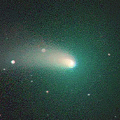
|
Now it is very bright as 8.3 mag (Dec. 18, Michael Jager). It will approach to Earth down to 0.29 a.u. in February, and it is expected to brighten up to 5 mag. In the Northern Hemisphere, it stays observable in excellent condition for a long time, although it became extremely low temporarily in November. In the Southern Hemisphere, it is not observable until early February.
Date(TT) R.A. (2000) Decl. Delta r Elong. m1 Best Time(A, h)
Dec. 24 15 53.76 28 20.7 1.251 1.158 61 8.1 5:34 (259, 37)
Dec. 31 15 53.24 30 40.0 1.066 1.132 66 7.7 5:37 (259, 44)
|

|
Now it is bright as 8.7 mag (Dec. 20, Chris Wyatt). It is observable at 8 mag for a long time from 2022 to 2023. In the Southern Hemisphere, it stays observable for a long time, although it becomes low temporarily from November to December. In the Northern Hemisphere, it is not observable until 2023 summer.
Date(TT) R.A. (2000) Decl. Delta r Elong. m1 Best Time(A, h)
Dec. 24 18 13.50 -62 2.7 2.458 1.798 38 7.9 18:24 ( 33,-33)
Dec. 31 18 43.72 -64 41.9 2.416 1.803 41 7.8 18:28 ( 30,-33)
|
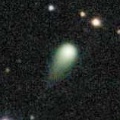
|
Now it is 10.8 mag (Dec. 20, Osamu Miyazaki). It stays bright as 10 mag for a long time until 2023 autumn. In the Northern Hemisphere, it stays observable in good condition until 2023 autumn. In the Southern Hemipshere, it stays unobservable until 2023 summer.
Date(TT) R.A. (2000) Decl. Delta r Elong. m1 Best Time(A, h)
Dec. 24 5 18.96 85 44.7 2.106 2.706 117 9.9 22:50 (180, 39)
Dec. 31 2 30.59 81 43.9 2.071 2.663 116 9.8 19:49 (180, 44)
|
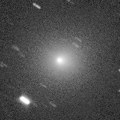
|
Brightening very rapidly. Now it is very bright as 10.7 mag (Dec. 19, Osamu Miyazaki). It stays 10-11 mag until March. In the Northern Hemisphere, it will be observable in good condition after this. In the Southern Hemisphere, it is not observable until 2023 June.
Date(TT) R.A. (2000) Decl. Delta r Elong. m1 Best Time(A, h)
Dec. 24 14 55.90 42 60.0 1.790 1.883 79 11.4 5:34 (243, 52)
Dec. 31 15 30.56 47 22.8 1.705 1.850 82 11.2 5:37 (236, 52)
|

|
It brightened up to 8.3 mag in last winter (Jan. 6, 2022, Toshiyuki Takahashi). Now it is fading. But it is bright as 11.6 mag still now (Dec. 20, Chris Wyatt).
Date(TT) R.A. (2000) Decl. Delta r Elong. m1 Best Time(A, h)
Dec. 24 9 58.26 -29 17.0 4.384 4.713 103 11.3 3:50 ( 0, 26)
Dec. 31 9 55.99 -30 30.7 4.347 4.752 108 11.3 3:20 ( 0, 24)
|
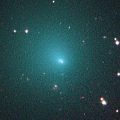
|
Now it is very bright as 10.4 mag (Nov. 23, Chris Wyatt). It will be fading after this. In the Southern Hemisphere, it becomes unobservable temporarily from December to January. In the Northern Hemisphere, it is not observable until spring when it fades down to 15 mag.
Date(TT) R.A. (2000) Decl. Delta r Elong. m1 Best Time(A, h)
Dec. 24 19 28.07 -38 20.5 2.492 1.629 22 11.3 18:24 ( 51,-12)
Dec. 31 19 27.37 -38 10.6 2.555 1.650 18 11.6 18:28 ( 55,-17)
|
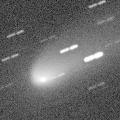
|
Now it is 11.7 mag (Dec. 19, Osamu Miyazaki). Appearing in the morning sky also in the Southern Hemisphere. It stays 11-12 mag until spring.
Date(TT) R.A. (2000) Decl. Delta r Elong. m1 Best Time(A, h)
Dec. 24 14 10.06 -11 0.1 1.892 1.601 57 11.5 5:34 (316, 32)
Dec. 31 14 29.28 -12 25.9 1.853 1.606 59 11.5 5:37 (320, 33)
|

|
Now it is 13.2 mag (Nov. 27, Ken-ichi Kadota). It is expected to brighten up to 11 mag in 2023. In the Southern Hemisphere, it stays observable in good condition for a long time, although it becomes unobservable temporarily from November to January. In the Northern Hemisphere, it is not observable until 2024 autumn.
Date(TT) R.A. (2000) Decl. Delta r Elong. m1 Best Time(A, h)
Dec. 24 18 16.57 -23 57.9 4.330 3.347 2 12.0 18:24 ( 72,-17)
Dec. 31 18 23.93 -25 5.7 4.301 3.321 3 11.9 5:37 (290,-16)
|
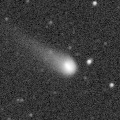
|
Now it is 13.2 mag (Nov. 16, Ken-ichi Kadota). It is expected to brighten up to 12 mag in 2023. In the Northern Hemisphere, it stays observable in good condition for a long time. It is appearing in the morning sky also in the Southern Hemisphere. It stays observable in good condition after this.
Date(TT) R.A. (2000) Decl. Delta r Elong. m1 Best Time(A, h)
Dec. 24 13 52.61 4 27.9 3.979 3.726 68 12.8 5:34 (308, 47)
Dec. 31 13 51.75 3 47.7 3.844 3.712 74 12.7 5:37 (318, 51)
|
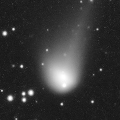
|
Now it is bright as 12.8 mag (Dec. 8, Hiroshi Abe). It stays 12 mag for a while. It stays observable in good condition for a while after this. It will be observable after January also in the Southern Hemisphere.
Date(TT) R.A. (2000) Decl. Delta r Elong. m1 Best Time(A, h)
Dec. 24 14 59.42 -1 15.8 5.106 4.548 50 12.9 5:34 (298, 32)
Dec. 31 15 5.80 -0 44.9 5.041 4.569 56 12.9 5:37 (302, 36)
|
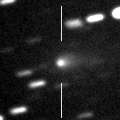
|
Now it is 13.4 mag (Nov. 26, Toshihiko Ikemura, Hirohisa Sato). It stays bright as 13 mag and observable in excellent condition until February.
Date(TT) R.A. (2000) Decl. Delta r Elong. m1 Best Time(A, h)
Dec. 24 8 44.68 7 58.8 0.985 1.847 139 13.0 2:36 ( 0, 63)
Dec. 31 8 44.66 8 37.4 0.954 1.856 146 12.9 2:09 ( 0, 64)
|
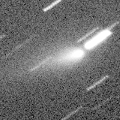
|
Outburst occured in early October, and it brightened up to 9.9 mag (Oct. 14, Thomas Lehmann). It is bright as 13.5 mag still now (Dec. 20, Chris Wyatt). It stays observable only until February in the Southern Hemisphere, or until March in the Northern Hemisphere.
Date(TT) R.A. (2000) Decl. Delta r Elong. m1 Best Time(A, h)
Dec. 24 22 52.82 -17 0.9 1.978 1.824 66 13.3 18:24 ( 29, 33)
Dec. 31 23 8.82 -14 53.0 2.103 1.888 63 13.7 18:28 ( 34, 33)
|

|
It brightened in major outburst in late November. Now it is very bright as 11.3 mag (Dec. 20, Chris Wyatt).
Date(TT) R.A. (2000) Decl. Delta r Elong. m1 Best Time(A, h)
Dec. 24 6 41.43 29 28.6 5.083 6.055 170 13.4 0:34 ( 0, 84)
Dec. 31 6 37.59 29 28.0 5.079 6.057 173 13.4 0:03 ( 0, 84)
|
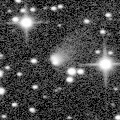
|
Now it is 14.2 mag (Dec. 20, Chris Wyatt). The brightness evolution is slower than originally predicted. It stays 13.5 mag until next summer. In the Northern Hemisphere, it stays observable in good condition until spring. In the Southern Hemisphere, it stays observable in good condition for a long time after this.
Date(TT) R.A. (2000) Decl. Delta r Elong. m1 Best Time(A, h)
Dec. 24 3 42.69 0 10.3 1.716 2.532 137 13.5 21:31 ( 0, 55)
Dec. 31 3 33.96 -2 47.7 1.756 2.485 128 13.5 20:54 ( 0, 52)
|

|
It will approach to Sun down to 0.1 a.u. on Jan. 31. In the Northern Hemisphere, it will appear in the morning sky at 9 mag in mid February, then it stays observable while the comet will be fading. In the Southern Hemisphere, it stays observable for a long time, although it is not observable from mid January to mid February.
Date(TT) R.A. (2000) Decl. Delta r Elong. m1 Best Time(A, h)
Dec. 24 19 31.33 -43 55.8 1.872 1.087 26 14.5 18:24 ( 46,-14)
Dec. 31 19 50.50 -42 40.7 1.746 0.944 24 13.6 18:28 ( 49,-16)
|
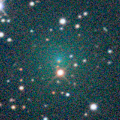
|
Brightening very rapidly. Now it is 12.9 mag (Dec. 15, Katsumi Yoshimoto). It brightens up to 13 mag in January. In the Northern Hemisphere, it stays observable in excellent condition. In the Southern Hemisphere, it is not observable until February.
Date(TT) R.A. (2000) Decl. Delta r Elong. m1 Best Time(A, h)
Dec. 24 20 9.80 72 57.9 0.811 1.364 98 13.9 18:24 (160, 40)
Dec. 31 21 9.53 75 40.5 0.741 1.344 101 13.6 18:28 (164, 41)
|
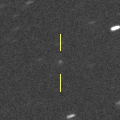
|
It will brighten up to 13 mag in winter. But the condition is bad. It is not observable until February in the Southern Hemisphere, or until May in the Northern Hemisphere.
Date(TT) R.A. (2000) Decl. Delta r Elong. m1 Best Time(A, h)
Dec. 24 17 9.98 -24 6.6 2.555 1.614 13 13.8 5:34 (294, -7)
Dec. 31 17 32.86 -24 52.6 2.532 1.604 15 13.7 5:37 (296, -6)
|
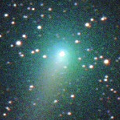
|
It brightened up to 9.3 mag in early summer (June 5, Chris Wyatt). Now it is fading. It has already faded down to 15.5 mag (Dec. 10, iTelescope Observatory, Siding Spring). In the Southen Hemisphere, it stays observable in good condition for a long time. It became observable also in the Northern Hemisphere. But it stays locating low for a while.
Date(TT) R.A. (2000) Decl. Delta r Elong. m1 Best Time(A, h)
Dec. 24 8 54.35 -43 29.8 2.590 2.969 102 13.9 2:46 ( 0, 11)
Dec. 31 8 37.61 -42 41.3 2.570 3.032 108 14.1 2:02 ( 0, 12)
|
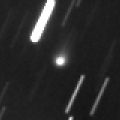
|
Now it is 14.4 mag (Dec. 20, Chris Wyatt). It stays 14 mag in 2023. In the Southern Hemisphere, it stays observable in good condition for a long time. It locates somewhat low in the Northern Hemisphere.
Date(TT) R.A. (2000) Decl. Delta r Elong. m1 Best Time(A, h)
Dec. 24 3 59.95 -23 17.2 2.907 3.550 123 14.3 21:47 ( 0, 32)
Dec. 31 3 44.30 -22 16.7 2.956 3.524 117 14.3 21:04 ( 0, 33)
|
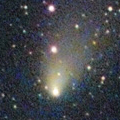
|
It brightened up to 10.4 mag from June to July (July 22, Ken-ichi Kadota). Now it is fading. Appearing in the morning sky in the Souther Hemisphere. However, now it is not detected, fainter than 17.5 mag (Nov. 29, Martin Masek). It will never be observable again in the Northern Hemisphere.
Date(TT) R.A. (2000) Decl. Delta r Elong. m1 Best Time(A, h)
Dec. 24 17 34.15 -64 20.3 3.082 2.432 41 14.7 5:34 (330,-30)
Dec. 31 18 6.32 -64 48.3 3.155 2.513 42 14.9 5:37 (330,-31)
|
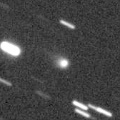
|
Now it is 14.8 mag (Dec. 20, Chris Wyatt). It is expected to brighten up to 8 mag in 2023 July. It will be getting lower after this. And it will be unobservable in February. In the Southern Hemisphere, it will be observable in excellent condition at the high light. In the Northern Hemisphere, it becomes very low at the high lihght.
Date(TT) R.A. (2000) Decl. Delta r Elong. m1 Best Time(A, h)
Dec. 24 0 44.82 -13 38.2 2.978 3.181 92 14.9 18:33 ( 0, 41)
Dec. 31 0 38.13 -13 45.8 3.049 3.112 84 14.9 18:28 ( 9, 41)
|

|
Now it is 14.8 mag (Dec. 8, ATLAS Chile). It will be unobservable soon. But it will be observable at 15 mag again in 2023.
Date(TT) R.A. (2000) Decl. Delta r Elong. m1 Best Time(A, h)
Dec. 24 20 40.41 -25 25.0 3.911 3.152 34 14.9 18:24 ( 51, 8)
Dec. 31 20 51.43 -24 40.6 3.971 3.161 30 15.0 18:28 ( 55, 5)
|

|
Now it is 15.1 mag (Oct. 26, Thomas Lehmann). The brightness evolution is slower than originally expected. It stays 14-15 mag for a long time. Now it is not observable. It will be observable in early January in the Northern Hemisphere, or in early February in the Southern Hemisphere.
Date(TT) R.A. (2000) Decl. Delta r Elong. m1 Best Time(A, h)
Dec. 24 17 38.19 -13 41.0 4.071 3.115 12 15.0 5:34 (282, -7)
Dec. 31 17 42.98 -12 27.4 4.065 3.138 17 15.0 5:37 (285, -1)
|
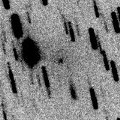
|
Now it is 17.6 mag (Oct. 25, Michael Jager). Tiny comet, but it will approach to Sun down to 0.8 a.u. in January, and to Earth down to 0.6 a.u. in March. It will brighten up to 14 mag from January to March. In the Southern Hemisphere, it stays observable in good condition for a long time. In the Northern Hemisphere, it is not observable now. It will become observable in early March.
Date(TT) R.A. (2000) Decl. Delta r Elong. m1 Best Time(A, h)
Dec. 24 20 55.49 -43 29.2 1.524 0.992 39 15.4 18:24 ( 36, -3)
Dec. 31 21 8.53 -46 35.4 1.481 0.930 38 15.0 18:28 ( 36, -7)
|
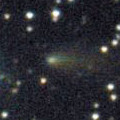
|
Now it is 14.2 mag (Dec. 9, Masayoshi Yoshimi). It stays observable in good condition at 15 mag from summer to winter. It locates somwwhat low in the Southern Hemisphere.
Date(TT) R.A. (2000) Decl. Delta r Elong. m1 Best Time(A, h)
Dec. 24 8 2.72 21 13.7 1.586 2.505 153 15.2 1:55 ( 0, 76)
Dec. 31 7 58.27 21 51.9 1.570 2.522 161 15.2 1:23 ( 0, 77)
|
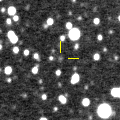
|
Now it is 15.8 mag (Dec. 15, ATLAS South Africa). It will brighten up to 13 mag from 2024 to 2025. It is observable in excllent condition in the Southern Hemisphere. It locates low in the Northern Hemisphere.
Date(TT) R.A. (2000) Decl. Delta r Elong. m1 Best Time(A, h)
Dec. 24 9 13.56 -37 52.1 6.511 6.829 104 15.4 3:05 ( 0, 17)
Dec. 31 9 12.15 -38 23.3 6.414 6.795 108 15.4 2:36 ( 0, 17)
|
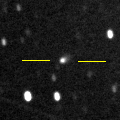
|
Now it is 15.4 mag (Dec. 15, ATLAS Chile). It is expected to brighten up to 7 mag in early 2024. In the Southern Hemisphere, it stays observable in good condition for a long time. In the Northern Hemisphere, it stays low in 2022.
Date(TT) R.A. (2000) Decl. Delta r Elong. m1 Best Time(A, h)
Dec. 24 5 49.17 -38 21.4 4.614 5.150 118 15.4 23:37 ( 0, 17)
Dec. 31 5 43.42 -38 33.2 4.563 5.085 116 15.4 23:03 ( 0, 16)
|
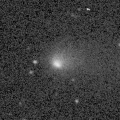
|
Now it is 15.2 mag (Dec. 12, W. Pei). It stays observable in good condition for a long time. But it will be fading after this, and it will be fainter than 18 mag in spring.
Date(TT) R.A. (2000) Decl. Delta r Elong. m1 Best Time(A, h)
Dec. 24 1 32.73 1 55.0 1.632 2.177 110 15.5 19:22 ( 0, 57)
Dec. 31 1 39.41 2 46.4 1.718 2.189 104 15.6 19:01 ( 0, 58)
|
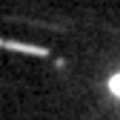
|
Now it is 16.7 mag (Dec. 3, Ken-ichi Kadota). It will brighten rapidly up to 14 mag in spring. In the Southern Hemisphere, appearing in the morning sky. It will be observable in excellent condition in spring. In the Northern Hemisphere, it is observable in good condition in winter, but it becomes somewhat low in spring.
Date(TT) R.A. (2000) Decl. Delta r Elong. m1 Best Time(A, h)
Dec. 24 13 35.95 -4 9.6 2.628 2.439 68 15.8 5:34 (320, 43)
Dec. 31 13 44.91 -5 41.7 2.532 2.428 72 15.6 5:37 (328, 44)
|
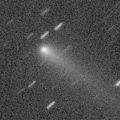
|
It brightened up to 14.1 mag in autumn (Nov. 14, Thomas Lehmann). Now it is fading. It has already faded down to 16.0 mag (Dec. 13, ATLAS-HKO, Haleakala). It stays observable in excellent condition for a while.
Date(TT) R.A. (2000) Decl. Delta r Elong. m1 Best Time(A, h)
Dec. 24 1 59.46 27 12.4 1.775 2.467 124 15.7 19:49 ( 0, 82)
Dec. 31 2 1.88 27 50.3 1.860 2.480 118 15.8 19:24 ( 0, 83)
|

|
Now it is 15.0 mag (Dec. 20, Chris Wyatt). It was expected to brighten up to 13 mag in spring. But actually, it was fainter than originally expected. In the Southern Hemisphere, it stays observable in good condition for a long time. In the Northern Hemisphere, it stays extremely low for a while.
Date(TT) R.A. (2000) Decl. Delta r Elong. m1 Best Time(A, h)
Dec. 24 2 43.14 -43 43.7 3.348 3.619 98 15.8 20:31 ( 0, 12)
Dec. 31 2 33.62 -41 13.2 3.447 3.653 94 15.9 19:54 ( 0, 14)
|
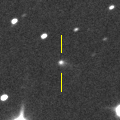
|
Now it is 15.2 mag (Dec. 7, Ken-ichi Kadota). It stays 16 mag and observable in good condition until spring.
Date(TT) R.A. (2000) Decl. Delta r Elong. m1 Best Time(A, h)
Dec. 24 9 35.59 19 14.0 2.664 3.399 131 15.9 3:27 ( 0, 74)
Dec. 31 9 36.67 20 1.4 2.589 3.391 138 15.8 3:01 ( 0, 75)
|
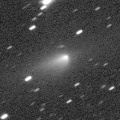
|
It brightened up to 12.7 mag in early 2022 (Feb. 27, Toshihiko Ikemura, Hirohisa Sato). Now it is fading. Now it is not observable. It will be observable agin at 16 mag in January in the Southern Hemisphere, or in February in the Northern Hemisphere.
Date(TT) R.A. (2000) Decl. Delta r Elong. m1 Best Time(A, h)
Dec. 24 16 48.85 -24 19.6 3.373 2.457 18 15.9 5:34 (297, -4)
Dec. 31 17 3.39 -24 46.5 3.363 2.477 21 16.0 5:37 (300, -1)
|
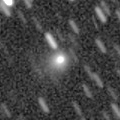
|
It brightened by 6 mag in outburst in early August up to 14.6 mag (Aug. 13, ATLAS-MLO, Mauna Loa). Now it is fading. It has already faded down to 16.8 mag (Dec. 12, A. Diepvens). It stays observable in good condition for a while.
Date(TT) R.A. (2000) Decl. Delta r Elong. m1 Best Time(A, h)
Dec. 24 21 49.42 -8 39.0 2.098 1.731 54 16.0 18:24 ( 50, 32)
Dec. 31 22 8.37 -8 25.4 2.142 1.724 52 16.0 18:28 ( 53, 30)
|
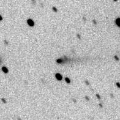
|
Now it is 16.1 mag (Dec. 10, Purple Mountain Observatory, XuYi Station). It will be observable at 16-17 mag in excellent condition from autumn to winter.
Date(TT) R.A. (2000) Decl. Delta r Elong. m1 Best Time(A, h)
Dec. 24 4 5.65 -1 40.1 2.668 3.489 141 16.2 21:54 ( 0, 53)
Dec. 31 4 3.17 -1 33.8 2.729 3.492 134 16.3 21:24 ( 0, 54)
|

|
It was observed at 15 mag from 2021 to 2022. Now it is fading. In the Southern Hemisphere, it stays observable in excellent condition for a long time, although it became extremely low temporarily in November. In the Northern Hemiphere, it is not observable after this.
Date(TT) R.A. (2000) Decl. Delta r Elong. m1 Best Time(A, h)
Dec. 24 15 12.70 -58 17.9 6.538 5.906 46 16.3 5:34 (335,-13)
Dec. 31 15 15.36 -59 22.8 6.508 5.934 50 16.3 5:37 (338,-12)
|
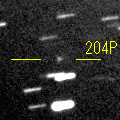
|
Now it is 17.3 mag (Dec. 1, ATLAS-HKO, Haleakala). It will brighten rapidly, and it will be observable at 16 mag in good condition in winter.
Date(TT) R.A. (2000) Decl. Delta r Elong. m1 Best Time(A, h)
Dec. 24 10 9.37 14 14.8 1.140 1.864 122 16.4 4:01 ( 0, 69)
Dec. 31 10 14.25 14 35.3 1.097 1.875 128 16.3 3:38 ( 0, 69)
|
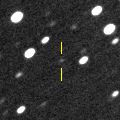
|
Now it is 16.4 mag (Dec. 9, ATLAS Chile). It is expected to brighten up to 12-13 mag from 2024 to 2025.
Date(TT) R.A. (2000) Decl. Delta r Elong. m1 Best Time(A, h)
Dec. 24 10 27.22 -20 6.2 6.154 6.451 103 16.5 4:19 ( 0, 35)
Dec. 31 10 23.94 -20 3.1 6.001 6.407 110 16.5 3:48 ( 0, 35)
|
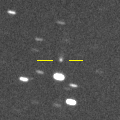
|
Now it is 17.7 mag (July 9, ATLAS Chile). It will brighten up to 16 mag in 2023. In the Southern Hemisphere, it stays observable in good condition for a long time. In the Northern Hemisphere, it will never be observable again.
Date(TT) R.A. (2000) Decl. Delta r Elong. m1 Best Time(A, h)
Dec. 24 14 12.27 -58 4.5 3.756 3.275 53 16.5 5:34 (341, -8)
Dec. 31 14 29.73 -60 2.8 3.707 3.267 56 16.5 5:37 (344, -9)
|
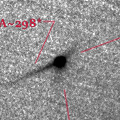
|
Due to the DART spacecraft impact to its satellite Dimorphos on Sept. 26, the cometary activity was detected. It brightened up to 12.9 mag (Sept. 28, John Drummond). It is fading after that. It has already faded down to 15.9 mag (Oct. 29, Katsumi Yoshimoto). It stays observable in good condition for a while.
Date(TT) R.A. (2000) Decl. Delta r Elong. m1 Best Time(A, h)
Dec. 24 7 57.79 27 49.1 0.233 1.199 154 16.5 1:50 ( 0, 83)
Dec. 31 7 45.67 29 14.1 0.259 1.235 163 16.6 1:11 ( 0, 84)
|

|
Appearing in the morning sky. It will brighten very rapidly. It is expected to be observable at 11 mag in excellent condition from spring to summer.
Date(TT) R.A. (2000) Decl. Delta r Elong. m1 Best Time(A, h)
Dec. 24 15 16.17 -23 31.7 2.949 2.274 39 17.1 5:34 (311, 13)
Dec. 31 15 31.76 -24 8.7 2.871 2.249 42 16.7 5:37 (314, 14)
|
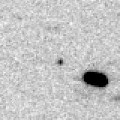
|
Now it is 16.9 mag (Dec. 12, D. Buczynski). It stays observable at 16 mag for a long time from early 2023 to early 2024. In the Northern Hemisphere, it is observable only until 2023 spring.
Date(TT) R.A. (2000) Decl. Delta r Elong. m1 Best Time(A, h)
Dec. 24 10 25.10 1 42.5 3.944 4.438 114 17.0 4:17 ( 0, 57)
Dec. 31 10 20.50 0 43.9 3.807 4.406 121 16.8 3:45 ( 0, 56)
|
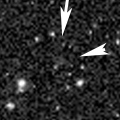
|
Now it is 16.7 mag (Dec. 15, ATLAS Chile). Very far object. It stays 17 mag for a long time from 2021 to 2026. In the Southern Hemisphere, it stays observable in good condition for a long time. In the Northern Hemisphere, it is not observable at all.
Date(TT) R.A. (2000) Decl. Delta r Elong. m1 Best Time(A, h)
Dec. 24 7 6.00 -76 15.4 10.587 10.460 79 16.9 0:57 ( 0,-21)
Dec. 31 6 50.62 -76 29.2 10.573 10.453 80 16.9 0:14 ( 0,-22)
|
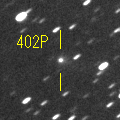
|
It brightened up to 15.3 mag in last winter (Jan. 12, 2022, H. Nohara). Now it is fading. It has already faded down to 17.0 mag (Dec. 1, ATLAS-HKO, Haleakala). It will be observable at 17 mag in good condition in next winter. It locates low in the Southern Hemisphere.
Date(TT) R.A. (2000) Decl. Delta r Elong. m1 Best Time(A, h)
Dec. 24 10 25.91 21 32.9 3.875 4.460 120 17.1 4:17 ( 0, 76)
Dec. 31 10 25.99 22 19.3 3.805 4.478 128 17.0 3:50 ( 0, 77)
|
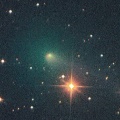
|
Now it is 15.9 mag (Nov. 25, Ken-ichi Kadota). It stays observable in good condition after this. But it will be fading gradually after this.
Date(TT) R.A. (2000) Decl. Delta r Elong. m1 Best Time(A, h)
Dec. 24 0 55.03 0 2.5 2.556 2.905 100 17.1 18:44 ( 0, 55)
Dec. 31 0 59.30 0 43.0 2.693 2.946 94 17.3 18:28 ( 3, 56)
|

|
It brightened very rapidly up to 15.5 mag from last autumn to last winter (Nov. 2, 2021, Toshihiko Ikemura, Hirohisa Sato). Now it is fading slowly. It has already faded down to 16.8 mag (Dec. 5, J.-G. Bosch, F. Kugel).
Date(TT) R.A. (2000) Decl. Delta r Elong. m1 Best Time(A, h)
Dec. 24 6 31.71 9 28.5 3.497 4.454 164 17.1 0:24 ( 0, 64)
Dec. 31 6 27.73 9 23.8 3.513 4.474 166 17.2 23:48 ( 0, 64)
|
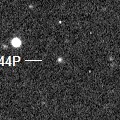
|
Now it is 17.4 mag (Nov. 18, Toshihiko Ikemura, Hirohisa Sato). It is observable at 17 mag in good condition in winter. It locates somewhat low in the Southern Hemisphere.
Date(TT) R.A. (2000) Decl. Delta r Elong. m1 Best Time(A, h)
Dec. 24 6 10.44 26 24.2 2.940 3.923 176 17.2 0:03 ( 0, 81)
Dec. 31 6 5.61 26 24.2 2.948 3.924 171 17.2 23:26 ( 0, 81)
|
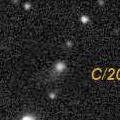
|
Now it is 17.7 mag (Dec. 15, ATLAS-HKO, Haleakala). It stays 17 mag and observable in good condition for a long time until 2023 summer.
Date(TT) R.A. (2000) Decl. Delta r Elong. m1 Best Time(A, h)
Dec. 24 13 36.22 4 16.4 9.126 8.867 71 17.3 5:34 (313, 50)
Dec. 31 13 36.01 4 33.2 9.010 8.871 78 17.2 5:37 (323, 54)
|

|
Now it is 16.9 mag (Dec. 12, A. Diepvens). Fading slowly. In the Northern Hemisphere, it stays observable in good condition for a long time. In the Southern Hemisphere, it is not observable after this.
Date(TT) R.A. (2000) Decl. Delta r Elong. m1 Best Time(A, h)
Dec. 24 17 49.36 63 22.8 9.597 9.594 86 17.3 5:34 (211, 30)
Dec. 31 17 54.35 63 44.8 9.605 9.610 87 17.3 5:37 (212, 33)
|

|
It brightened up to 14 mag in 2021. Now it is fading. It has already faded down to 16.8 mag (Dec. 7, Z. Banfalvy). It will be fainter than 18 mag in March.
Date(TT) R.A. (2000) Decl. Delta r Elong. m1 Best Time(A, h)
Dec. 24 23 18.73 15 29.3 6.667 6.659 85 17.4 18:24 ( 46, 64)
Dec. 31 23 20.47 15 42.9 6.816 6.698 78 17.4 18:28 ( 58, 60)
|
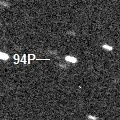
|
Now it is 18.8 mag (Dec. 1, ATLAS-HKO, Haleakala). It brightens rapidly, and it is observable at 16.5 mag in good condition in spring. It locates somewhat low in the Southern Hemisphere.
Date(TT) R.A. (2000) Decl. Delta r Elong. m1 Best Time(A, h)
Dec. 24 8 53.92 24 22.0 1.592 2.445 142 17.6 2:46 ( 0, 79)
Dec. 31 8 52.29 24 58.3 1.527 2.426 149 17.4 2:17 ( 0, 80)
|
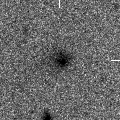
|
Now it is 17.2 mag (Dec. 3, ATLAS Chile). Very large comet. It is expected to brighten up to 14 mag in 2031. In the Southern Hemisphere, it stays observable in good condition for a long time. In the Northern Hemisphere, it is not observable until 2030.
Date(TT) R.A. (2000) Decl. Delta r Elong. m1 Best Time(A, h)
Dec. 24 2 30.70 -61 0.1 18.238 18.178 84 17.4 20:19 ( 0, -6)
Dec. 31 2 29.41 -60 47.8 18.259 18.152 82 17.4 19:50 ( 0, -6)
|
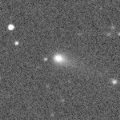
|
Now it is 17.3 mag (Nov. 25, Toshihiko Ikemura, Hirohisa Sato). It continued brightening even after the perihelion passage. It will be fading after this, and it will be fainter than 18 mag in February.
Date(TT) R.A. (2000) Decl. Delta r Elong. m1 Best Time(A, h)
Dec. 24 23 14.92 -2 29.7 4.584 4.464 76 17.4 18:24 ( 31, 48)
Dec. 31 23 19.58 -2 5.3 4.702 4.478 70 17.5 18:28 ( 40, 45)
|
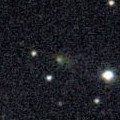
|
Now it is 17.0 mag (Dec. 13, Purple Mountain Observatory, XuYi Station). It will be fading after this, and it will be fainter than 18 mag in January.
Date(TT) R.A. (2000) Decl. Delta r Elong. m1 Best Time(A, h)
Dec. 24 2 53.73 22 38.9 1.970 2.759 135 17.5 20:43 ( 0, 78)
Dec. 31 2 53.99 22 16.5 2.068 2.788 128 17.6 20:15 ( 0, 77)
|
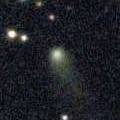
|
Now it is 17.1 mag (Dec. 14, A. Diepvens). Fading slowly. In the Southern Hemisphere, it is not observable after this.
Date(TT) R.A. (2000) Decl. Delta r Elong. m1 Best Time(A, h)
Dec. 24 17 19.09 39 39.4 6.218 5.856 64 17.5 5:34 (238, 26)
Dec. 31 17 27.03 40 17.2 6.225 5.887 65 17.5 5:37 (239, 30)
|

|
Now it is 18.3 mag (Dec. 15, ATLAS-HKO, Haleakala). It brightens rapidly, and it is observable at 16.5 mag in good condition from January to March.
Date(TT) R.A. (2000) Decl. Delta r Elong. m1 Best Time(A, h)
Dec. 24 9 48.17 14 43.8 0.458 1.314 127 17.8 3:39 ( 0, 70)
Dec. 31 10 14.56 16 14.3 0.418 1.288 129 17.5 3:38 ( 0, 71)
|
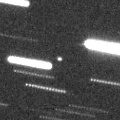
|
Now it is 17.0 mag (Nov. 26, Toshihiko Ikemura, Hirohisa Sato). It will be fading after this.
Date(TT) R.A. (2000) Decl. Delta r Elong. m1 Best Time(A, h)
Dec. 24 7 46.53 19 32.7 0.829 1.776 156 17.6 1:39 ( 0, 74)
Dec. 31 7 33.88 19 48.0 0.864 1.836 166 17.5 0:59 ( 0, 75)
|
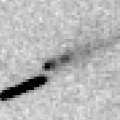
|
It brightened up to 16.1 mag in autumn (Sept. 23, Michael Jager). Then it is fading very rapidly. It has already faded down to 18.0 mag (Nov. 26, H. Nohara). It will be getting higher after this also in the Southern Hemisphere.
Date(TT) R.A. (2000) Decl. Delta r Elong. m1 Best Time(A, h)
Dec. 24 11 12.19 -4 27.1 1.434 1.887 100 17.5 5:03 ( 0, 50)
Dec. 31 11 15.91 -6 5.6 1.399 1.924 106 17.6 4:40 ( 0, 49)
|

|
Now it is 17.3 mag (Dec. 3, H. Nohara). It stays 17 mag for a long time from 2023 to 2024. It is observable in good condition in the Northern Hemisphere. It locates low in the Southern Hemisphere.
Date(TT) R.A. (2000) Decl. Delta r Elong. m1 Best Time(A, h)
Dec. 24 2 20.62 28 9.4 6.455 7.116 129 17.6 20:10 ( 0, 83)
Dec. 31 2 20.14 28 3.0 6.529 7.101 122 17.6 19:42 ( 0, 83)
|
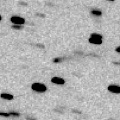
|
Now it is 17.3 mag (Dec. 3, Ken-ichi Kadota). In the Northern Hemisphere, it stays observable at 17 mag in good condition for a long time until winter. In the Southern Hemisphere, it stays extremely low for a long time.
Date(TT) R.A. (2000) Decl. Delta r Elong. m1 Best Time(A, h)
Dec. 24 8 11.41 50 59.9 2.238 3.085 143 17.6 2:04 (180, 74)
Dec. 31 8 6.42 51 4.8 2.243 3.116 147 17.7 1:31 (180, 74)
|

|
Now it is 16.5 mag (Dec. 12, ATLAS Chile). It brightened up to 14 mag from 2020 to 2021. Now it is fading slowly. It will be fainter than 18 mag soon. But it may stay bright for some more time.
Date(TT) R.A. (2000) Decl. Delta r Elong. m1 Best Time(A, h)
Dec. 24 0 10.40 -15 16.2 4.158 4.181 84 17.6 18:24 ( 8, 40)
Dec. 31 0 13.54 -14 26.2 4.278 4.197 78 17.7 18:28 ( 17, 39)
|

|
It brightened up to 14.2 mag in 2021 summer (July 18, 2021, Taras Prystavski). Now it is fading. It has already faded down to 17.0 mag (Dec. 13, ATLAS Chile). In the Southern Hemisphere, it stays observable in good condition for a long time. It locates somewhat low in the Northern Hemisphere.
Date(TT) R.A. (2000) Decl. Delta r Elong. m1 Best Time(A, h)
Dec. 24 1 14.16 -20 3.2 5.747 5.935 96 17.7 19:03 ( 0, 35)
Dec. 31 1 13.99 -19 5.2 5.894 5.979 90 17.7 18:35 ( 0, 36)
|

|
Now it is 17.6 mag (Dec. 2, ATLAS Chile). It is observable at 17.5 mag in good condition in winter.
Date(TT) R.A. (2000) Decl. Delta r Elong. m1 Best Time(A, h)
Dec. 24 9 4.18 0 32.5 2.772 3.503 131 17.8 2:56 ( 0, 55)
Dec. 31 9 2.86 0 8.3 2.705 3.500 138 17.7 2:27 ( 0, 55)
|
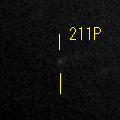
|
Now it is 18.9 mag (Nov. 24, Catalina Sky Survey). It brightens up to 17.5 mag from January to February. It locates somewhat low in the Southern Hemisphere.
Date(TT) R.A. (2000) Decl. Delta r Elong. m1 Best Time(A, h)
Dec. 24 11 39.67 14 23.1 1.980 2.387 102 17.8 5:31 ( 0, 69)
Dec. 31 11 46.58 14 59.8 1.908 2.397 107 17.8 5:10 ( 0, 70)
|

|
It brightened up to 12.3 mag from spring to summer in 2021 (June 15, 2021, Marco Goiato). Now it is fading. It has already faded down to 18.2 mag (Nov. 21, D. Buczynski). It will be fainter than 18 mag in January.
Date(TT) R.A. (2000) Decl. Delta r Elong. m1 Best Time(A, h)
Dec. 24 12 44.19 34 39.9 6.137 6.318 96 17.8 5:34 (268, 77)
Dec. 31 12 43.06 35 44.4 6.079 6.365 102 17.8 5:37 (262, 84)
|

|
It is observable at 17 mag from winter to spring. It locates low in the Southern Hemisphere.
Date(TT) R.A. (2000) Decl. Delta r Elong. m1 Best Time(A, h)
Dec. 24 9 49.73 29 3.7 2.059 2.799 130 18.0 3:41 ( 0, 84)
Dec. 31 9 50.45 30 6.0 1.980 2.781 136 17.9 3:15 ( 0, 85)
|
|
![]()
 C/2022 U2 ( ATLAS )
C/2022 U2 ( ATLAS ) 71P/Clark
71P/Clark C/2021 E3 ( ZTF )
C/2021 E3 ( ZTF ) C/2021 X1 ( Maury-Attard )
C/2021 X1 ( Maury-Attard ) C/2021 P4 ( ATLAS )
C/2021 P4 ( ATLAS ) C/2021 T4 ( Lemmon )
C/2021 T4 ( Lemmon ) 117P/Helin-Roman-Alu 1
117P/Helin-Roman-Alu 1 C/2020 R7 ( ATLAS )
C/2020 R7 ( ATLAS ) C/2022 S3 ( PanSTARRS )
C/2022 S3 ( PanSTARRS ) 119P/Parker-Hartley
119P/Parker-Hartley C/2021 G2 ( ATLAS )
C/2021 G2 ( ATLAS ) C/2021 S3 ( PanSTARRS )
C/2021 S3 ( PanSTARRS ) 61P/Shajn-Schaldach
61P/Shajn-Schaldach 77P/Longmore
77P/Longmore P/2022 L3 ( ATLAS )
P/2022 L3 ( ATLAS ) C/2020 Y2 ( ATLAS )
C/2020 Y2 ( ATLAS ) C/2020 S4 ( PanSTARRS )
C/2020 S4 ( PanSTARRS ) 116P/Wild 4
116P/Wild 4 285P/LINEAR
285P/LINEAR 408P/2020 M7 ( Novichonok-Gerke )
408P/2020 M7 ( Novichonok-Gerke ) C/2018 U1 ( Lemmon )
C/2018 U1 ( Lemmon ) 204P/LINEAR-NEAT
204P/LINEAR-NEAT C/2022 E2 ( ATLAS )
C/2022 E2 ( ATLAS ) C/2021 C5 ( PanSTARRS )
C/2021 C5 ( PanSTARRS ) (65803) Didymos
(65803) Didymos 237P/LINEAR
237P/LINEAR C/2022 A3 ( Lemmon-ATLAS )
C/2022 A3 ( Lemmon-ATLAS ) C/2019 E3 ( ATLAS )
C/2019 E3 ( ATLAS ) 402P/2020 Q3 ( LINEAR )
402P/2020 Q3 ( LINEAR ) 22P/Kopff
22P/Kopff P/2021 N2 ( Fuls )
P/2021 N2 ( Fuls ) 244P/Scotti
244P/Scotti C/2020 F2 ( ATLAS )
C/2020 F2 ( ATLAS ) C/2019 O3 ( Palomar )
C/2019 O3 ( Palomar ) C/2020 F5 ( MASTER )
C/2020 F5 ( MASTER ) 94P/Russell 4
94P/Russell 4 C/2014 UN271 ( Bernardinelli-Bernstein )
C/2014 UN271 ( Bernardinelli-Bernstein ) 395P/2020 H1 ( Catalina-NEAT )
395P/2020 H1 ( Catalina-NEAT ) 44P/Reinmuth 2
44P/Reinmuth 2 C/2020 H6 ( ATLAS )
C/2020 H6 ( ATLAS ) 263P/Gibbs
263P/Gibbs 107P/(4015) Wilson-Harrington
107P/(4015) Wilson-Harrington 157P/Tritton
157P/Tritton C/2021 S4 ( Tsuchinshan )
C/2021 S4 ( Tsuchinshan ) C/2021 QM45 ( PanSTARRS )
C/2021 QM45 ( PanSTARRS ) 246P/NEAT
246P/NEAT C/2019 F1 ( ATLAS-Africano )
C/2019 F1 ( ATLAS-Africano ) P/2021 V2 ( Fuls )
P/2021 V2 ( Fuls ) 211P/Hill
211P/Hill C/2020 J1 ( SONEAR )
C/2020 J1 ( SONEAR ) 180P/NEAT
180P/NEAT![]()




























































